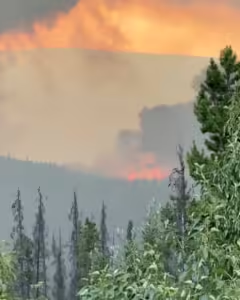Climate Change Impact on the U.S. by 2100

Rising Heat Waves:
By the year 2100, the United States is poised to face a multitude of challenges wrought by the relentless march of climate change. Among these challenges, rising temperatures will catalyze a series of events that will reshape the very fabric of American society.
Coastal Flooding:
One of the most palpable impacts will be the proliferation of heat waves, particularly in urban centers, where concrete jungles amplify the effects of rising temperatures. These heat waves will not only pose immediate health risks, especially to vulnerable populations such as children and the elderly but also strain infrastructure and energy systems, exacerbating the heat island effect.
Wildfire Outbreaks:
Simultaneously, coastal regions, particularly in the Southeast, will find themselves increasingly under siege by the encroaching tides. Sea level rise, a consequence of global warming, threatens homes, vital infrastructure, and the livelihoods of millions of people who call these vulnerable areas home. The specter of coastal flooding looms large, necessitating robust adaptation and mitigation efforts to safeguard against its devastating impacts.
Food Insecurity:
Meanwhile, the American West will witness a dramatic uptick in the frequency and intensity of wildfires. Fueled by drier conditions and exacerbated by prolonged heatwaves, these infernos will ravage vast swathes of land, posing significant risks to both human health and delicate ecosystems. The toll on communities, both in terms of lives lost and economic devastation, will be staggering.
Expanded Disease Risks:
In addition to these more immediate threats, climate change will also sow the seeds of food insecurity across the nation. Disrupted crop yields and fisheries, coupled with the loss of arable land due to coastal flooding and wildfires, will strain food supply chains, imperiling both agricultural economies and marine ecosystems. The ripple effects of food insecurity will be felt far and wide, exacerbating social inequalities and driving further instability.
Moreover, warmer temperatures will expand the habitat ranges of vector-borne diseases, such as Lyme disease, exposing more Americans to the perils of infectious diseases. Public health infrastructure will be put to the test as healthcare systems grapple with the dual challenges of managing both chronic conditions exacerbated by heatwaves and emerging infectious threats.
Climate-Driven Migration:
As these climate-induced crises intensify, so too will the phenomenon of climate-driven migration. Displaced populations will seek refuge from disaster-prone areas, placing immense strain on host communities and testing the limits of existing infrastructure and social services. The resultant population shifts will further exacerbate social tensions and inequities, posing unprecedented challenges for policymakers and planners alike.
Thus, the impacts of climate change on the United States by the end of the century will be profound and far-reaching. From the scorching heatwaves of urban centers to the raging wildfires of the West, from the inundated coastlines of the Southeast to the specter of food insecurity and disease outbreaks, no corner of the nation will be untouched by the ravages of a warming planet. Urgent and decisive action is needed to mitigate these impacts and build a more resilient future for generations to come.
Re-reported from the article originally published in The Smithsonian Magazine









